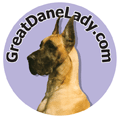 |
GREATDANELADY.COM Linda Arndt ~ Canine Nutritional Consultant Email: |
 |
|
Anal Gland and Tonsillitis |
|
The
Relationship Between Tonsillitis and Anal Glands Rafe was not always a big eater, unlike most of my dogs that are
willing to eat until the drop. In fact, Rafe has always self regulated
his weight by backing off on his food consumption every third day.
But when he would go longer than a day without wantint to eat or picking
out the soft meat pieces, when there were no other signs of illness,
this really got my attention. Finally I realized the two issues were related. There was a pattern of anal glands flaring up, excessive licking, then the tonsils would flare up and become infected, then Rafe goes off his feed because he has a sore throat. I knew I had to get a handle on this problem and stop the cycle, because I would never put another dog through anal gland surgery again! That in itself is a whole other story and the majority of times can and should be avoided. Keep in mind you can handle this anal glad and tonsil issue with an adjustment in diet and a simple little external treatment. Stopping the Cycle - External Management There is a time and a place for antibiotics and tonsillitis is one of them. As much as I don't like to use antibiotics some times it is necessary. As long as I use probiotics to reestablish the environment of the gut with beneficial bacteria, there is no worry of systemic yeast infections or lowering the immune function. This is how we manage the infected anal glands - instead of treating
systemically with an antibiotic, we treat with an antibiotic at the
point of entry, so to speak, the anal gland ducts. Here is where owning
a giant breed comes in handy because you can actually see them very
clearly (if you so included to look for them), smaller breeds
are easier to "express" but more difficult to locate the
ducts for antibiotic infusion.
Now, have the vet get in there and empty them out and this needs to be done by inserting a rubber gloved finger in the dog and get behind the anal sack and give it a good squeeze. "Youch" - the dog will not like this one bit. This can not be donel by simply trying to squeeze from the outside, especially if there is an infection or they are impacted. If you have not had this lovely experience before, let me warn you, keep your self covered and have plenty of paper towels and Clorox wipes handy---- a nice can of air freshener would not hurt either. Might I also suggest not wearing your best clothes during this process. It is not at all unusual to drain 1/2 - 1 cup of infection and fluid off one gland (Great Dane) if they are really infected or impacted. (this is not a job for sissies, that's for sure). I always try to tip my vet after this procedure because he has earned his money! After the vet empties the sack, then infuse them with antibiotic
using a syringe (approximately 10 CC - the kind with no needle, but
a long plastic curved tip). Insert the antibiotic filled syringe into
the ducts and fill them with Panalog or Animax (nystatin-neomycin
sulfate-thiostrepton-triamcionlone acetonide) antibiotic ointment.
This is a safe semi-painless way to handle it without that terribly painful anal gland removal surgery, which is a very difficult for the dogs! It is my experience antibiotics taken internally will NOT take care of this problem, you have to infuse the anal duct with antibiotic. Try this first method first because it has a VERY high rate of success. Dietary Management Example: for an adult Great Dane, make sure they get 1/3 cup of water or broth (a little canned meat is good too for variety) on each meal along with the dosage of POOPITY DOO, you will find the dosage on the bottle. Infusing with antibiotic and a slight change in diet will help prevent the reoccurrence of anal gland problems and reoccurring tonsillitis in our dog.This is a much better way of handling these interrelated health concerns than having to go through costly, painful and risky anesthesia/surgery. At least it is well worth the try. Another Story: Jone Mizer, from Steinlove Setters- England wrote me to tell me of her experience with anal glands. This is certainly a natural and safe way to try and correct the problem. " Years ago my veterinarian told me that one of his clients
who owned a Rottweiler that had |
|
|